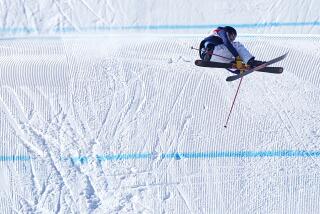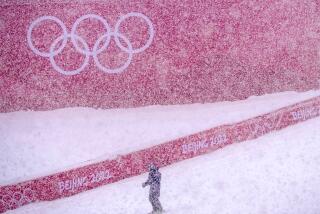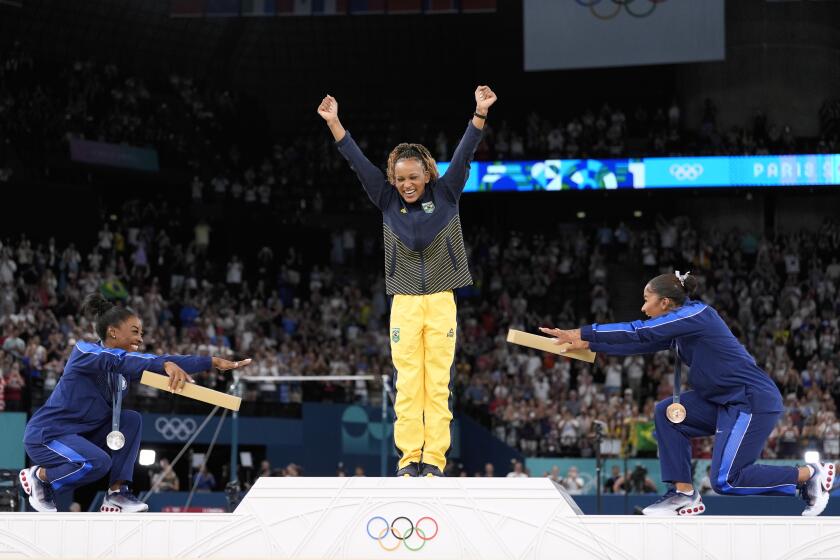Well, It’s Not All Downhill From Here
HAKUBA, Japan — Frustrated that he wasn’t rising fast enough as a world class slalomist, Matt Grosjean nearly quit the United States Ski Team two years ago.
In fact, he had one ski pole out the door.
Like an aging pitcher, Grosjean was looking for a new pitch to keep him in the big leagues.
He thought he found it in an Olympic alpine sport known as combined.
The event produces a winner by adding the times of a separate slalom and shortened downhill.
The combined appealed to Grosjean because the format heavily favors slalom specialists over speed racers--technical skiers can amass a larger time differentials in their event--yet many slalom skiers are scared off by the perils of downhill.
Grosjean wasn’t afraid. With his career on the line and Nagano in his sights, he trained downhill last summer in Chile and in Tignes, France. This winter, he raced the two most feared downhills on the World Cup circuit, the Lauberhorn in Wengen, Sweden, and the famed Hahnenhamm in Kitzbuehel, Austria.
So, wouldn’t you know it.
Tuesday, in the slalom portion of the Olympic combined--Grosjean’s specialty--he missed a gate on the second run and was eliminated from the competition.
Grosjean had posted the third-fastest time in the first run.
“It’s just frustrating,” Grosjean said afterward. “To measure it right now is impossible for me because I had a shot here. I was hungry for this.”
Instead, Austria’s Mario Reiter won the combined slalom with a two-run time of 1 minute 31.85, 1.81 seconds faster than Norway’s Lasse Kjus, the defending Olympic combined champion, and 2.64 seconds ahead of Poland’s Andrzej Bachleda, a student at the University of Denver.
Austria’s Hermann Maier, one of the gold-medal favorites, could not survive a disastrous first run in which he almost came to a complete stop trying to back track to a gate.
Maier enters the downhill combined 4.05 seconds behind Reiter.
If Maier really is Alpine’s Superman, here’s a chance to prove it.
Reiter’s finish was fairly shocking. Although a gate specialist, he is ranked only 25th in the current World Cup slalom standings.
Reiter took advantage of a difficult course setting that made many downhillers look like amateurs.
“This was an advantage for me,” Reiter said. “So I had to make the best use of it. I have had a terrible season and I am very lucky to be on the Austrian team at the Olympics at all.”
Although Reiter holds what would appear a significant time advantage, Thursday’s downhill combined figures to be interesting because the Austrian is not a downhiller by trade.
Kjus, to the contrary, is a great downhiller and could very well make up the 1.81 seconds on Reiter.
Kjus summed it up succinctly.
“I need to ski really fast in the downhill and he needs to ski slow,” Kjus said.
Bachleda, in third place, is also a pure slalomist and will unlikely be able to hold his position.
Maier thinks the race will now be won by a Norwegian.
“Kjus now can win the gold,” the Austrian said.
Others within striking distance include Austria’s Christian Mayer, who is 3.20 seconds off the pace, and Norway’s Kjetil Andre Aamodt, who trails Reiter by 3.41 seconds. Aamodt won the silver in combined at the 1994 Lillehammer games.
As the challengers plot their race strategy, Grosjean must contemplate his future. He is 27 now, with a wife, Torrie, and two sons--Cody and Austin.
His family stayed home in Aliso Viejo, Calif.
Grosjean may decide it’s time to move on. He has an honorable, if not memorable, career. He finished 10th in slalom at the 1992 Albertville Olympics, and has had four top-10 World Cup finishes--but never a podium.
Grosjean interned with Charles Schwab, working out of the company’s Newport Beach and Irvine offices.
His future is not bleak, but he had hoped to bring home good news from Nagano.
Grosjean still has another race, next week’s Olympic slalom in Shiga Kogen, but he does not figure to challenge the likes of Italy’s Alberto Tomba and the Austrians--Thomas Stangassinger and Thomas Sykora.
Grosjean ranks only 32nd in the world in the event.
The combined was Grosjean’s chance to steal an Olympic medal.
“The event, obviously, is good for a good slalom skier who is not afraid to go fast in the downhill,” Grosjean said.
To have been eliminated in the slalom event was only more demoralizing.
How many hours did Grosjean devote to the downhill, an event he will now not even be able to compete?
“I don’t want to count them right now,” he said.
Grosjean might have played it safe after finishing third in the first run with a time of 48.32. But Grosjean said he had to garner as large a time lead as he could on the downhill specialists.
“I knew I had to be the fastest second run of slalom,” he said. “I went out of the gate very aggressively. I was looking to make up time.
“I was going to take chances, go for it,” he said. “I knew if I skied a fast run, I could have been up on top.”
Grosjean will not try and regroup before next week’s slalom.
“I’m going to take a break, go out and see some events, and try to put this behind me,” he said. “Then, I’ll start training.”
American Tommy Moe, who finished fifth in combined at the Lillehammer Games, decided not to compete this year.
Two other Americans--Jason Rosener and Chad Fleischer--entered the combined but skied off course in the first run.
More to Read
Go beyond the scoreboard
Get the latest on L.A.'s teams in the daily Sports Report newsletter.
You may occasionally receive promotional content from the Los Angeles Times.








